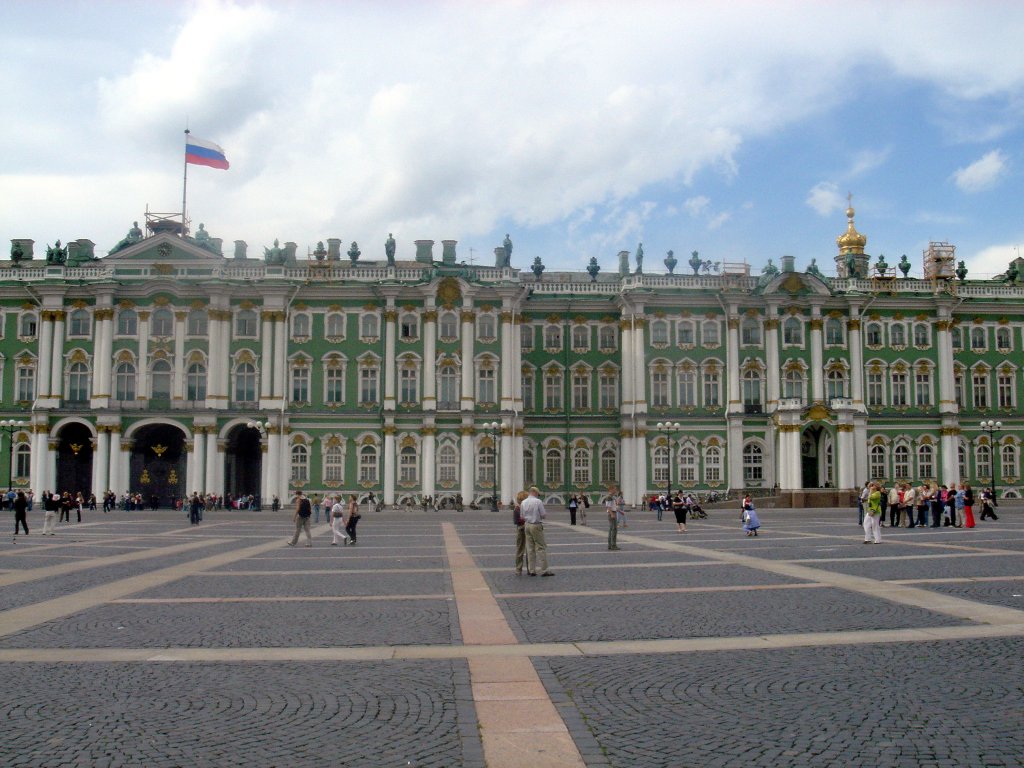« Old Customs | Main | Festival Time »
September 03, 2006
A Journey into the Past
Two years ago my parents went on a cruise on the Baltic Sea. By chance I discovered the photographs of their trip a few days ago. It took them along the coasts of Germany, Poland, Russia, Finnland and Sweden. Apart from being able to visit quite a few well known and famous towns it also provided my mother with the opportunity to see again the farm she grew up on as a child. Even after almost 60 years it was exactly as she had remembered it. The farm is situated in an area that now belongs to Poland.
One of the most stunning cities my parents visited was doubtless St Petersburg. As the Monk wrote two days ago it was the armoured cruiser 'Aurora' which started the October Revolution in 1917 by firing at St Petersburg's Winter Palace. Here you see what she was aiming at.

The Winter Palace, now part of the Hermitage Museum complex
A great number of St Petersburg's buildings has been lovingly restored in recent years. The Winter Palace is now one of five buildings that form the well know Hermitage Museum.
The foundations for St Petersburg were laid in 1703. Tsar Peter the Great wanted to build a new capital at the mouth of the river Newa. Not a brilliant idea it seems as the area consisted mainly of swamps and was flooded regularly. Many died during while the town was built. In 1712 Peter the Great declared St Petersburg the new capital of the Russian Empire which she stayed until 1918 except for a brief period from 1728 to 1732 when the Court moved temporarily back to Moscow.
Peter the Great wanted a 'window into the west' and tried to make St Petersburg a centre for European Science and Technology right from the start. However, when he died in 1725 the enthusiasm of the Russian Emperors for the 'window' subsided briefly and the Court moved to Moscow. But Tsarina Anna returned to St Petersburg and made substantial modifications regarding the layout of the city.
Most of the magnificent buildings were erected during the reign (1741-62) of Tsarina Elisabeth. She invited many artists and architects from Western Europe to work in St Petersburg. The Catharine Palace was extended to honour her mother Catharine I - a tribute indeed.

The Catharine Palace originating from 1717, planned by the German architect Johann-Friedrich Braunstein.
During the reign (1762-1792) of Catherine the Great scientists were encouraged to settle down in St Petersburg and schools were founded, among them the first public school for girls. The abolishment of serfdom in 1861 under Tsar Alexander II encouraged a great number of people to move to this town and the number of inhabitants increased considerably.
On the other hand all important revolts and revolutions of the Russian history until 1918 also took place in St Petersburg. As mentioned before the October revolution started with the Aurora firing at the Winter Palace. Well, looking at all the splendour and magnificence found in St Petersburg which takes me straight back to all of Dostoevski's novels I've read in my youth and which was only available to very few people while the rest of the Russian people had to live under very different circumstances I do not find it astonishing that revolutions took place here. I'd say they were bound to happen sooner or later. I had the same feeling when I saw some of the famous castles at the Loire in France for the first time.
It's a good thing those times are over and a lot more of us can now enjoy places like St Petersburg.
Posted by Mausi at September 3, 2006 10:10 PM
Trackback Pings
TrackBack URL for this entry:
http://mt3.mu.nu/mt/mt-tb.cgi/4642
Comments
I saw your pictures of St. Petrsburg and would like to use them on the website I am developing for the Rachmaninov Society USA.
I traveled their last year but my available photos at the moment are limited.
I apprecaite your blog and telling of your mother.
Matushka Carol
Posted by: Matushka Carol at September 19, 2006 03:36 AM